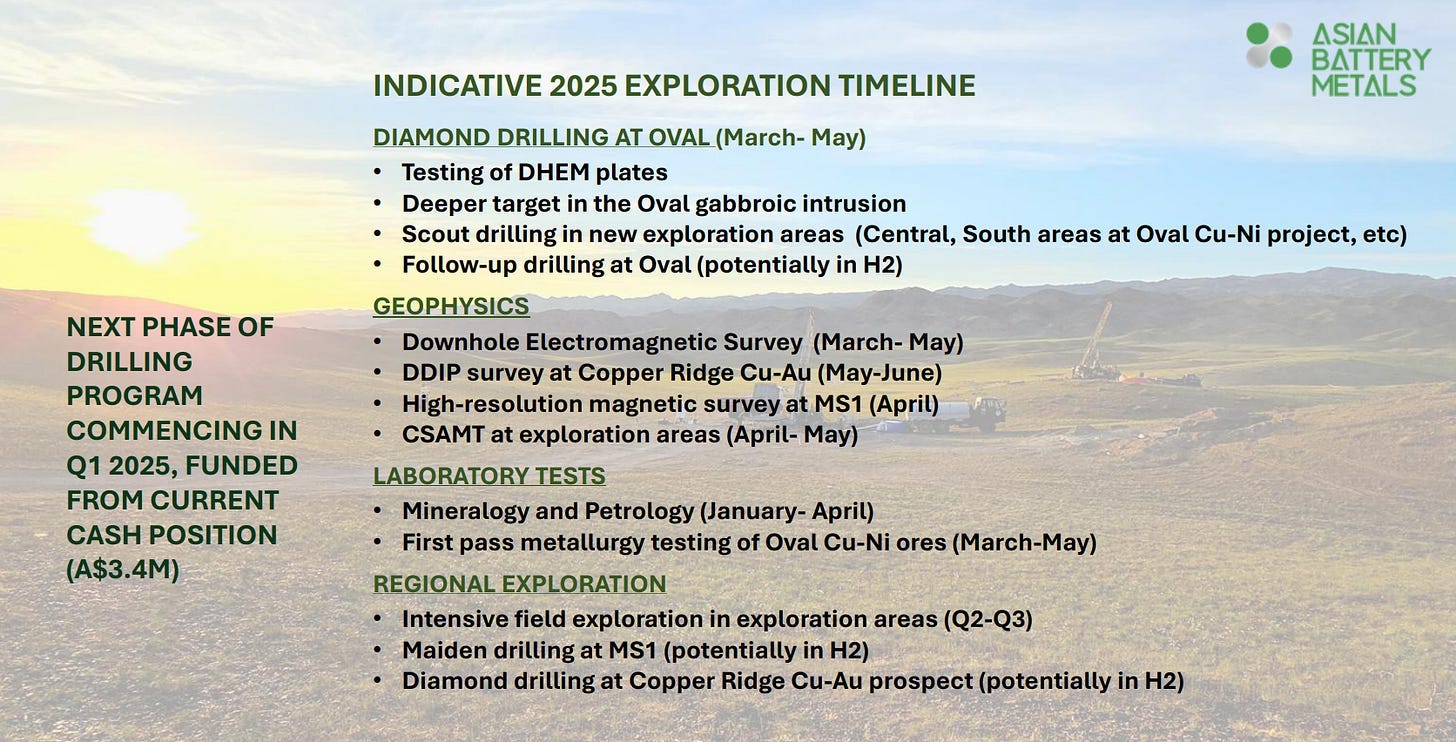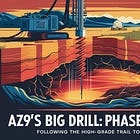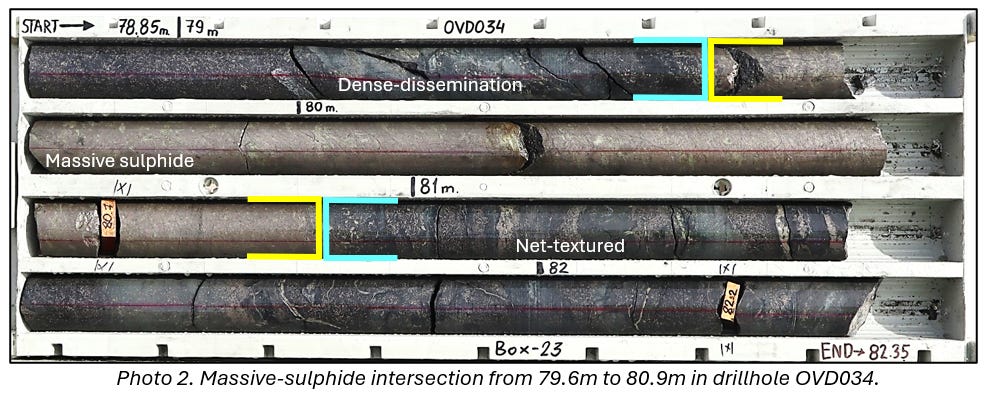AZ9 Zeroes In on the Source Beneath Oval
Drilling at Oval may have just tagged the copper source. If confirmed, it could rewrite the AZ9 story.
Asian Battery Metals (ASX: AZ9) has dropped a bullish drilling update from its Oval discovery in southern Mongolia.
The latest results show thick zones of high-grade mineralisation, a possible feeder system at depth, and several new EM conductors lighting up the map - all of which strengthen the case for a larger copper–nickel–PGE system taking shape beneath the surface.
This might be the most encouraging update we’ve seen from AZ9 so far. Firstly, the sulphides are back. From high-grade zones to the more textured, disseminated kind.
But it’s what’s happening deeper down that’s really interesting.
The latest holes suggest things are starting to line up underground. The story has now evolved beyond isolated hits near the surface, and we're seeing hints of structure - an emerging system that could explain where this mineralisation is coming from and how it's flowing.
One hole in particular has tagged what looks like a channel - think of it as a geological corridor that might lead back to the source. If that proves true, it’s exactly the kind of setup you’d hope for in a magmatic copper-nickel system.
With AZ9 trading at just 3.1c, finding the primary source could deliver meaningful upside for early investors.
It’s still early, but are we bullish? Absolutely.
Let’s break down what’s been drilled, what it means, and why the next few holes might just be the ones that tie it all together.
Oval: Already Promising, Now Potentially a Whole Lot More
The Oval discovery sits within AZ9’s 100%-owned Yambat Project - a large landholding in Mongolia prospective for copper, nickel, and PGEs.
AZ9 had already pulled up some eye-catching hits at Oval, including multiple high-grade massive sulphides. But this Phase 3 drilling program is going deeper than ever and aiming to answer a much bigger question: Where is all this mineralisation coming from?
“The results from OVD032 and the deeper part of OVD033 are a game-changer for the Oval discovery in understanding the potential pathway of the magmatic conduit.”
- Gan-Ochir Zunduisuren, Managing Director of AZ9
The team has now completed eight diamond drillholes, racking up nearly 1,900m of core - and has three goals in mind:
Hit more of the known mineralised zones.
Step out to test the edges.
And crucially, chase down the potential source. This is the ‘engine room’ that could be feeding the whole system.
Should they confirm a feeder conduit or chamber beneath Oval, it could flip this from a cluster of high-grade zones into a large, unified copper-nickel system.
That’s the kind of change that moves share prices.
The Three Holes That Matter and What They Showed
1. The Emergence of a Feeder System
Hole OVD032 is shaping up as a breakthrough in the current campaign.
It went deeper than previous holes and pulled up 1.8 metres of high-grade sulphide, including a 0.5m stretch of semi-massive material. Visually, it’s pointing to high copper grades, though we’ll know more when assays land.
But what really matters is where it was hit.
The geology suggests this could be a feeder - a natural channel that once carried metal-rich material up from deeper underground. That’s significant because feeders often trace back to the real source of the mineral system.
If AZ9 has tapped into that source, we could be looking at a large copper–nickel–PGE system taking shape at depth.
And if that’s the case, it changes the picture and would re-write the fortunes of AZ9 and its shareholders instantly.
2. Thick Zones of Mineralisation
Hole OVD033 delivered another strong hit, with 28.7 metres of high-grade sulphide just below 90 metres. It’s a thick intercept that adds weight to the idea of a growing system.
More importantly, further down around 160 metres, it hit a 5.5-metre stretch estimated to contain over 3% chalcopyrite - a copper-rich mineral that, if backed by assays, would point to strong copper content for a junior explorer.
The layering looks continuous rather than patchy - exactly how bigger systems tend to behave.
And the deeper rocks are getting coarser, which is often a sign of a nearby heat source - another tick for a larger system sitting beneath Oval.
3. Confirming and Extending the System
Hole OVD034 was designed to follow up on an earlier high-grade hit, and it didn't disappoint.
The drill cut through over 57 metres of sulphide mineralisation with varying intensities - from scattered traces to dense, even massive zones.
The standout was a 1.3-metre section made up mostly of metal-rich minerals - including around 20% chalcopyrite (the main copper-bearing mineral) and 74% pyrrhotite, which often turns up alongside it.
That kind of mineralisation is rare at this stage.
Massive sulphides like this typically sit closer to the heart of a mineral system, where metals tend to concentrate most heavily. And crucially, it lines up with earlier holes - helping confirm that the mineralisation here isn’t random, it’s continuous and it’s expanding.
Geophysics guiding the next steps
This round isn't just about what's come out of the ground; it's also about mapping what lies hidden beneath.
AZ9 has run downhole electromagnetic surveys to sniff out more sulphides nearby. Those scans flagged several promising targets at depth, including one around 300 metres below OVD032.
These zones show up because metal-rich rocks conduct electricity differently. And the deeper they are, the more likely they’re connected to the primary source of the system, like a feeder or metal-rich chamber.
This means AZ9 isn't stabbing in the dark with their next round of drilling; they've got proper targets mapped out and ready to test.
What to Expect Next
The visuals so far are strong. The geological picture is getting sharper too, and with lab results for the above holes due in late May, we won’t be waiting long.
In the meantime, AZ9 has more work lined up: deeper drilling to test the possible feeder, fresh ground surveys to map what’s below, and fieldwork across nearby targets.
Management’s not standing still - they’ve got a clear path, and the next steps are already in motion.
Building Towards Finding The Source
This drill campaign is starting to show a system that changes with depth, which is what we had anticipated previously.
Near the surface, the mineralisation is lighter. But deeper down, it thickens and gets heavier.
Taken together, this suggests AZ9 isn’t just scratching around the edges. They could be closing in on the deeper source feeding the system.
It’s early, but these are the kind of signs that often precede a much larger copper–nickel–PGE discovery.
Final word
Exploration’s a puzzle.
You get a few pieces at a time - and if you’re lucky (and know what you’re doing), they start to form a picture.
What AZ9 has shown with this update is that Oval isn’t just a string of lucky hits. It’s evolving into a coherent system with depth, structure, and now the tantalising signs of a feeder.
There’s still plenty we don’t know. But this phase has taken the story from “one to watch” to “one that could be onto something.”
And if they really are on the trail of the source, the next few drill holes could be the most important yet, changing the fortunes of everyone involved.











